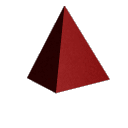Exercise 1B
Full credit will only be given to correct answers with a clear
explanation
of how they are obtained. Use additional paper as necessary.
 Imagine
a
tetrahedral die with four faces labeled "A", "C", "G",
and
"T" occurring with probabilities P(A)=
0.3, P(C) = 0.2, P(G) = 0.25, and Imagine
a
tetrahedral die with four faces labeled "A", "C", "G",
and
"T" occurring with probabilities P(A)=
0.3, P(C) = 0.2, P(G) = 0.25, and
P(T)
=
(Hint:
Given a sample space, S, and a
probability function, P, we must have that P(S)=1.)
-
The nucleotide base pair C and G can form 3 hydrogen bonds between them,
while A and T can form only 2. The bonding between C and G is therefore
stronger than that between A and T. For this reason, C and G are called
"strong" bases, while A and T "weak" bases.
According to
the chemical structure of the bases, A and G are classified as
"purines"
while C and T "pyrimidines". Write down the probabilities of
the
events S = {C, G}, W = {A, T}, R = {A, G}, Y =
{C, T}. (Hint: Recall the Axiom of Finite Additivity).
A. P(S) = 0.05,
P(W) = 0.075, P(R)
= 0.075, P(Y) = 0.05
B. P(S) = 0.45,
P(W) = 0.55, P(R) =
0.55, P(Y) = 0.45
C. P(S) = 1.35,
P(W) = 1.10, P(R) =
1.35, P(Y) = 1.10
D. None of the
above.
-
When this tetrahedral die is rolled two times, what is the probability
that the outcomes of the two rolls are both strong bases? Both
weak bases?
Both strong bases or both purines?
  (Hint: At
least two
rules of probability will be used in this problem. The Axiom of
Finite Additivity and the rule for taking the
intersection of independent
events. It may also
help to think of "and" as "intersection" and "or" as "union" ). (Hint: At
least two
rules of probability will be used in this problem. The Axiom of
Finite Additivity and the rule for taking the
intersection of independent
events. It may also
help to think of "and" as "intersection" and "or" as "union" ).
Both strong bases:
A. 0.1000
B. 0.9000
C. 0.1505
D. 0.2025
Both weak bases:
A. 0.1500
B. 0.0908
C. 0.3025
D. 0.5000
One strong and one weak base?
A. 0.4950
B. 0.2475
C. 0.5050
D. 0.1200
Both strong bases or both purines:
Hint: Use the following Theorem: If P is a probability function and A and
B are any sets in S, then
P(A U B) = P(A) + P(B) - P(A intersection B)
A. 0.5050
B. 0.4425
C. 0.0000
D. 0.5675
-
Given that the tetrahedral die is rolled two times
  , and both
rolls
result in
a strong base. What is the probability that at least one of these rolls
is a purine? (Hint) , and both
rolls
result in
a strong base. What is the probability that at least one of these rolls
is a purine? (Hint)
A. 0.7525
B. 0.8525
C. 0.8025
D. 0.2025
-
When this die is rolled three times, what is the probability that the
sequence
of bases generated is not a stop codon?
   (Hint:
Recall that
if P is a probability function and A is any set, then P( Ac ) =
1
- P(A). So, find P(A), where A=getting a stop codon, and then subtract it
from 1.). (Hint:
Recall that
if P is a probability function and A is any set, then P( Ac ) =
1
- P(A). So, find P(A), where A=getting a stop codon, and then subtract it
from 1.).
A. 0.5000
B. 0.9400
C. 0.0600
D. 0.6000
-
When this die is rolled four times, what is the probability that the
sequence
of bases generated is a palindrome? (A palindrome is a sequence of bases
which is the same as its complementary sequence read in the reverse
direction.
AATT, GATC are examples. Biologically, you can think of palindrome as a
fragment of DNA which is identical on both strands).
   
A. 0.3275
B. 0.0175
C. 0.0625
D. 0.0463
| |